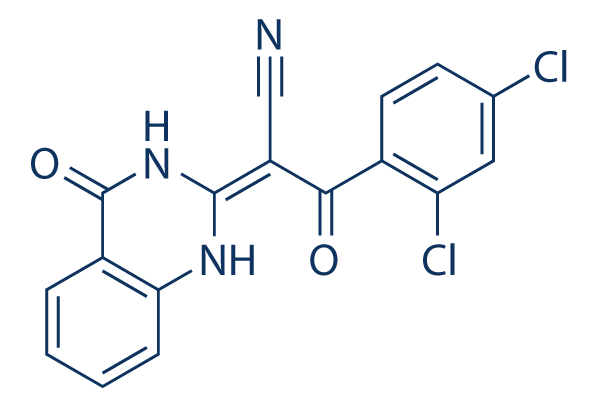All AbMole products are for research use only, cannot be used for human consumption.

In vitro: Ciliobrevin A (HPI-4) significantly inhibited the proliferation of these neuronal progenitors, as measured by histone H3 phosphorylation (pH3) levels, It also reduced cellular levels of cyclin D1 protein and Gli1, Gli2, and N-Myc transcripts in the Cerebellar Granule Neuron Precursors. Ciliobrevin A (HPI-4) acts by perturbing ciliogenesis. Treatment with HH pathway inhibitor-4 (HPI-4) could significantly decrease human chondrosarcoma cell proliferation, invasion and migration ability. Furthermore, Ciliobrevin A could distinctly disturb HH pathway-mediated ciliogenesis and suppress primary cilia-related protein intraflagellar transport protein IFT88 expression. HH downstream effect molecular GLI2 was restrained to block parathyroid hormone-related protein and affect MAPK/ERK-regulated matrix metalloproteinases (MMP2 and MMP9). Ciliobrevin A (HPI-4) is also a small molecule inhibitor of the catalytic heavy chain subunit of cytoplasmic dynein.
In vivo: Pancreatic fibrosis and destruction were effectively prevented by the treatment of Ciliobrevin A (HPI-4), a ciliogenesis inhibitor, in zebrafish model.
| Cell Experiment | |
|---|---|
| Cell lines | The human chondrosarcoma cell line SW1353 |
| Preparation method | Using MTS-8 assay to measure cell proliferation and the toxicity of this drug. 2000 cells were plated in 96-well plates per well. HPI-4 was added to cells at concentrations of 0, 5 and 10 μM in 100 μl DMEM/F12 with 10% FBS and incubated for 0, 1, 3, 6 and 9 days. Then, 10 μl MST-8 was added to the media in each well and incubated in an environment without light for 90 min. The absorbance value was measured using an enzyme microplate reader at 450 nm wavelength. The relative viability of cells was expressed by OD value. |
| Concentrations | 0, 5 and 10 μM |
| Incubation time | 0, 1, 3, 6 and 9 days |
| Animal Experiment | |
|---|---|
| Animal models | zebrafish |
| Formulation | water |
| Dosages | 5 uM |
| Administration | |
| Molecular Weight | 358.18 |
| Formula | C17H9Cl2N3O2 |
| CAS Number | 302803-72-1 |
| Solubility (25°C) | DMSO 65 mg/mL |
| Storage |
Powder -20°C 3 years ; 4°C 2 years In solvent -80°C 6 months ; -20°C 1 month |
| Related Hedgehog Products |
|---|
| TPB15
TPB15 is an orally potent Hh (Hedgehog) signaling inhibitor that significantly induces MDA-MB-468 cell cycle arrest and apoptosis. TPB15 also blocks Smo (Smoothened) translocation into cilia and reduces Smo protein and mRNA expression. In addition, TPB15 can inhibit the expression of downstream regulator Glioma-associated oncogene 1 (Gli1). TPB15 has good anti-tumor activity and low toxicity. |
| Hedgehog IN-3
Hedgehog IN-3 is a hedgehog pathway inhibitor (IC50 = 0.01 µM). |
| Hedgehog IN-5
Hedgehog IN-5 is an orally active small molecule inhibitor of the hedgehog pathway. |
| Hedgehog IN-2
Hedgehog IN-2 is an inhibitor of Hedgehog pathway with an IC50 value less than 0.003 μM in C3H10T1/2 cells. |
| Physalin H
Physalin H is an inhibitor of Hedgehog (Hh) signaling and it disrupts GLI1-DNA-complex formation. Physalin H inhibits GLI1 transcription with an IC50 value of 0.7 μM. Physalin H shows cytotoxicity to PANC1 and DU145 cells with IC50 values of 5.7 and 6.8 μM, respectively. |
All AbMole products are for research use only, cannot be used for human consumption or veterinary use. We do not provide products or services to individuals. Please comply with the intended use and do not use AbMole products for any other purpose.


Products are for research use only. Not for human use. We do not sell to patients.
© Copyright 2010-2024 AbMole BioScience. All Rights Reserved.
